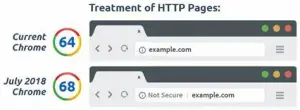Chrome continues to evolve, launching Chrome 68 for Windows, Mac, and Linux. The update includes new features for users, and developers as well as many security enhancements, and bug fixes. Chrome provides 68 users with the ability to control both redirects and is often misused.
The small rotating ad displayed on the site is embedded in an internal structure that may contain code that overwrites the browser and sends it to other sites. With Chrome 68, iframe redirection will open a window that allows users to choose to switch to a new website or stay the same.

The request unit is redirected to a location where the user may want to move to another location to open a new browser window. The companion site is usually in a new browser window hidden in the main browser and cannot be seen when the focus browser is not closed or is minimized. Sites with porn boards and love blow, Chrome 68 alerts users to tabs and gives you the option to migrate to a new website as needed.
The above two changes were designed in Chrome 68 to improve the Internet security. The “unsafe” warning for HTTP sites is a negative change. The user must pay attention to the label, and understand its meaning for the desired effect. Blocking unwanted redirects leads to a more aggressive approach by forcing the user to grant redirect completion permissions.
Features of Chrome 68
Alert users when they visit unencrypted sites: Network security is more important than ever, and the company wants to do its part to protect users. Chrome will be alerting users to starting with the Chrome 68, and “insecure” HTTP sites. You will see these alerts in your browser as of this month. Therefore, inform the users. If you continue to migrate your in-house or third-party applications to HTTPS, and you want to prevent the display of warnings to users, you can also opt out of this notification on a per-domain basis.

Allow users to sign in at any time through PIN: For users who need to log in and quit devices that do not have access to the keyboard, for example, a retail partner using a tablet, a numeric password may be required. Although Chrome OS PIN has been logged in for a while, it was only allowed to log in after logging in for the first time. With Chrome 68, you can now log in with your digital PIN at any time.
Enable automatic re-enrollment: If managing a device is your responsibility, losing or losing a device is sometimes unavoidable. In the past, if a remote device is lost and restored, the user will have to enter credentials on the device to re-enroll in its domain.
Chrome OS controlled operating system Chrome 68 will automatically re-register after the network connection, the re-registration step will stop without entering any authentication. This feature will be more and more and will become the default feature for new and existing customers who have not changed their default settings to re-register.
Material design refresh: It includes new round labels, buttons, and minibars in the form of a pill that reflects the new curvature in recent Google updates. At the same time, it includes the most accurate adjustments to minibar dropdowns, animations, animations, and floating effects of new tab icons. It’s not clear when Google plans to start redesign.
Page lifecycle API: These developers can pause the background guide when prompted. On the web, websites work consistently with Android and iOS apps, and Android and iOS apps can be turned on and off to save battery power and resources.


















